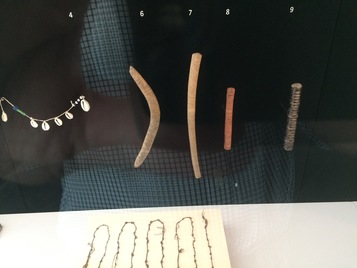| Coordinates WGS84 | 13°22'S, 141°44'E -13.36, 141.73 |
GMD33050
Title: A message stick from North Queensland held in the Grassi Museum Dresden (Museum für Völkerkunde Dresden)
Description: SKD online catalogue: "Botschaftsstock - Botenstab zur Nachrichtenübermittlung" (Google translated to: Embassy stick - Messenger staff for message transmission).
Creator of Object: Unknown
Date Created: 1914
Notes on date created: terminus ante quem
Item type: message stick in a collection
State/Territory: QLD
Notes on linguistic areas: The message stick is associated with Northeast Australia, North Queensland, Aurukun Mission Station.
Dimension 1: 115mm Dimension 2: 12mm Dimension 3: 12mm
Materials: wood
Techniques: carved and colored
Source types: museum collection
Date collected: Acquisition date 1914
Institution/Holder file: Museum of Ethnology Dresden (The Grassi Museum Dresden) object identifier: 33050
Coordinates: 13°21'30.200400"S,141°43'40.800000"E (-13.358389, 141.728)
Media copyright: Museum of Ethnology Dresden (The Grassi Museum Dresden)
Notes on coordinates: Absolute coordinates for Aurukun, Queensland, per Google maps. Wikipedia: The Aurukun Mission (known then as the Archer River Mission Station) was established on 4 August 1904.
URL institution: https://skd-online-collection.skd.museum/Details/Index/1560130
Notes: Note that artefact no. 9 in the full photograph is of a sheep counting stick from the Aran Islands, Ireland, and not an Australian message stick. 29.2.24 NR: according to GMD: "Cultural context - Aurukun (acquisition)" 28.5.24 NR: Object was previously on display at the Deutsches Buch- und Schriftmuseum, Leipzig (and was labeled in OCCAMS as DBSM08), with the following display information: From museum placard: "Merkhilfe für Einladungen: Botenstäbchen und Botschaftsstock Südwest-Australien und Nord-Queensland. Anfang 20. Jh. Museum für Völkerdunde Dresden, Staatliche Ethnographische Sammlungen Sachsen, Staatliche Kunstsammlungen Dresden. Hölzerne Botenstäbe wurden in Australien verwendet, um Botschaften über große Entfernungen an andere Stammesgruppen zu übermitteln. Die eingeritzten Zeichen oder Kerben dienten als Gedächtnisstütze für die meist jungen Männer, die Einladungen zu Trauerfeiern und anderen rituallen Festen sowie Ort und Zeit zur Austragung von Kämpfen mündlich überbrachten. Gleichzeitig gewährten die Stäbe den Trägern Immunität beim Betreten von feindlichen Gebiet." Google translate: "Memory aid for invitations: messenger sticks and message sticks for Southwest Australia and North Queensland. Early 20th century: Museum für Völkerdunde Dresden, State Ethnographic Collections of Saxony, State Art Collections Dresden. Wooden messenger sticks were used in Australia to convey messages over long distances to other tribal groups. The carved symbols or notches served as a reminder for the mostly young men, who verbally conveyed invitations to funeral ceremonies and other ritual celebrations as well as the place and time for fighting. At the same time, the staffs granted the bearers immunity when entering enemy territory."
Media Files:
Data Entry: Piers Kelly, Nitzan Rotman



